WTDWehrtechnische Dienststelle 91: Detonation of a Bunker Buster
Technology- Date:
- Reading time:
- 2 MIN


The detonation can still clearly be felt inside the small reinforced concrete bunker that is situated on a small hill at a distance of 17 kilometers from the entrance of the Bundeswehr Technical Center for Weapons and Ammunition (WTDWehrtechnische Dienststelle 91).
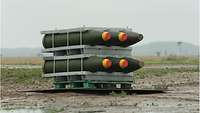
These six bombs are supposed to survive the detonation. Comprehensive testing at WTDWehrtechnische Dienststelle 91 is important for ammunition transport and storage safety of the so-called bunker busters.
Bundeswehr/WTD 91Approximately an hour earlier, on a Monday in June, a WTDWehrtechnische Dienststelle 91 ammunition transport stops at the demolition site close to the bunker. A wheel loader unloads six bombs with a total weight of approx. three tons and puts them right in the center of the site. The huge weapon is a bunker buster with a length of approximately two meters. Once all the tests have been completed, the bombs are supposed to be used on the Eurofighter aircraft.
“Today, we are going to check the behavior of the other bombs after one of them has detonated” explains Sebastian Dartmann, test manager for today's detonation. “Ideally, nothing will happen. In the worst case, the other bombs also detonate.” According to Dartmann, such trials are important for planning ammunition transports as well as for bomb storage.
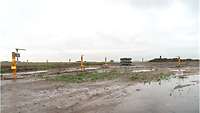
Bad weather conditions do not keep the WTDWehrtechnische Dienststelle 91 women and men from carrying out the tests. Once the test setup has been completed, everybody is waiting for the approval for the detonation.
Bundeswehr/WTD 91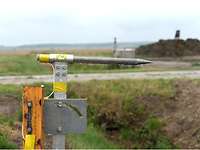
Several pressure sensors are anchored to the ground in a circle around the bomb. The tip of the measuring probe measures the pressure. Afterwards, measuring engineers calculate whether it was a detonation or a burning.
Bundeswehr/WTD 91Preparing such a trial is labor-intensive. “Of course, we need a lot of metrology to be able to understand what exactly happens during such an incident,” says the 35-year-old mechanical engineer. “Furthermore, regulations with respect to environmental protection, occupational safety, noise protection and many other things must be taken into account.”

Furthermore, regulations with respect to environmental protection, occupational safety, noise protection and many other things must be taken into account.
While he is recounting the conditions and requirements, WTDWehrtechnische Dienststelle 91 firing control reports by radio. “We have to interrupt,” Dartmann informs the range technicians. In order to exclude the so-called focus, a meteorological investigation must be carried out. “During certain meteorological conditions the blast wave may be reflected back to earth from the sky. As a consequence, window panes, somewhere several kilometers away, may burst. Of course, we would like to prevent this from happening by carrying out these investigations.”
After a few minutes, the all-clear is announced. “We can start now,” says Dartmann. Everybody has to leave the demolition site. At some hundred meters distance, there is a Bundeswehr armored transport vehicle, behind that, an ambulance and the Bundeswehr fire brigade - just in case. Only Mr Dartmann and a colleague are allowed to stay in the bunker on the edge of the demolition site. “We sometimes work with untested ammunition and prototypes. Thus, on principle, we are very cautious,” explains Dartmann, who is a native of the nearby city of Lingen.
The moment has come. Everyone in the bunker is very focussed. Sebastian Dartmann is looking out of the narrow ballistic glass window at the demolition site. Next to him, the screens of the video cameras and other metrological sensors are flickering. He is holding a small box with a red button in his hands. He turns the crank and counts down. Three. Two. One.
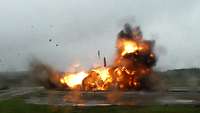
The huge explosion is recorded from a safe distance. Among other things, technicians use the recordings for later evaluation.
Bundeswehr/WTD 91A bunker buster is detonated at the Bundeswehr Technical Center for Weapons and Ammunition (WTDWehrtechnische Dienststelle 91) in Meppen. The bomb is approximately two meters long. Once all the tests have been completed, the weapons are to be used on Eurofighter aircraft.
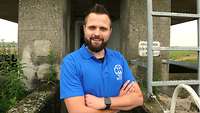
Sebastian Dartmann is a mechanical engineer. At WTDWehrtechnische Dienststelle 91, the civil servant works with explosives and pyrotechnics. Today, as test manager, he is responsible for the detonation.
Bundeswehr/Dominik Wullers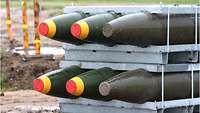
Testing is carried out to ensure the safety of future operators and logistics personnel. It takes the highest priority.
Bundeswehr/WTD 91
Bad weather conditions do not keep the WTDWehrtechnische Dienststelle 91 women and men from carrying out the tests. Once the test setup has been completed, everybody is waiting for the approval for the detonation.
Bundeswehr/WTD 91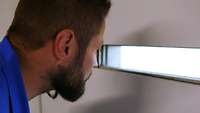
Shortly before the detonation, Sebastian Dartmann has a last look at the test set-up. The technical civil servant checks once more that nobody is in the danger area.
Bundeswehr/WTD 91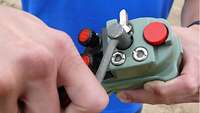
Ignition device: The test manager uses this small box to cause a big explosion. The crank is used to charge the capacitor until a small light is lit. The detonation is initiated by pushing the red button.
Bundeswehr/WTD 91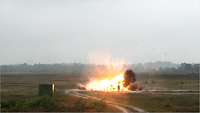
Observed from a safe distance: The charge detonates at the demolition site with a big bang.
Bundeswehr/WTD 91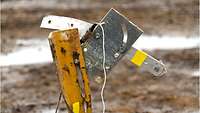
The blast wave left visible marks on the pressure sensor. In spite of the deformation, the measured values were recorded reliably.
Bundeswehr/WTD 91